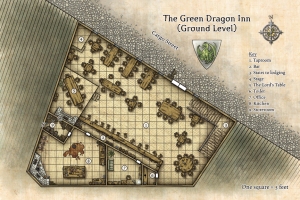If you’ve played any of the published adventures in 4th Ed. D&D, then you are familiar with the work of Mike Schley. In my opinion, Mike’s visual style is very closely tied to the overall palette of 4th Ed. and clearly WOTC feels the same way as his work is a part of many of their published products. I recently had the opportunity to ask Mike a few questions, so here now are 1d12 Questions with… Mike Schley:
First, I’ll ask you two important questions: Are you a gamer? And if you are, do you prefer playing or DM’ing?
Yes, I love gaming. Though I haven’t had the time recently for a regular weekly game I always love a good campaign. I love to DM but playing a character is just as fun, especially if you have the room to really develop your character and the party’s story.
Give us a little bit about your background in the hobby. How did you get into fantasy cartography and how did you get your first big break into D&D?
I started playing with some friends back in the mid-eighties. We were all in middle school so needless to say the adventures weren’t too complex back then. I loved drawing the campaign maps and character profiles and spent a huge amount of time mapping everything from new worlds to five-foot grid versions of my own neighborhood. Like a lot of folks I fell out of the hobby in high school and college but picked it back up later on.
As for my career, I originally started working in the fantasy RPG field as associate art director for Dungeon Magazine while it was being published by Paizo. Working with the art and editorial staff over there was an absolute blast. Before then I had worked as an in-house designer for the gaming company Decipher so I already had a bit of exposure to the gaming industry. After a while at Paizo I noticed that I was constantly looking for high quality cartographers to contribute to the magazine. Unfortunately there just weren’t as many out there as I would have liked.
There were tons of illustrators but very few cartographers in comparison. Later on, as I began thinking about pursuing a career as an artist and leaving the role of managing artists to other folks, I recalled the need for quality cartographers and called Rob Lazzaretti over at the WotC. He was running WotC’s in-house cartography department at the time. I showed him some of my previous work and he was kind enough to toss a project my way.
Looking at the work I did back then makes me cringe. I had a lot to learn but luckily they have stuck with me over the years.
In my opinion, your visual style is now closely tied to 4th Ed., as many of the introductory products included your cartography. Was that accidental, or were you tapped to be one of 4th Ed.’s primary cartographers from the beginning?
Although I can’t speak to what was going on behind the scenes at WotC, simply because I wasn’t in-house, they did let me know that I would be helping establish the flavor of 4th Ed. Cartography. I think they may have also asked some other cartographers to emulate my style but that’s just a guess.
Tell us a bit about the map making process. What tools do you use, and how do you approach a map? Do you have a digital palette where you just draw stuff from, like set dressings (tables, statues) for example, or is a new map completely original from top to bottom?
The process of making a map is actually similar to that of inking and flatting comics. Once I have the basic sketch imported into Photoshop and all the standard design elements in place, like the background texture and grid, I begin by laying down my inks.
Organization is absolutely critical since the inks will serve as templates for selections and masks down the line. After the inks are done I send the image off for approval and if I have the green light I then move on to painting the colors underneath my ink layers. I maintain a large content library of inked objects to pull from.
The key is just using the inks and not the colors to build scenes that would otherwise take forever to draw. This way I can have a dozen barstools inked in a flash while giving them all unique lighting and color treatments.
Walk us through the design of an adventure. Do the writers work jointly with the cartographers as the adventure is being written, or do you get basic descriptions of the encounter areas once the adventure is written and get to add your creativity to the process? How much of the map is your own creation vs. the needs of the writers?
Many times I receive sketches from the writer only after they have worked out all the details of the adventure setting. In those cases I generally keep to the script since a map must work with the story it’s illustrating. It all depends on the project though. Some require a more strictly facts approach while others leave more up to my own interpretation. By far the most fun is when I have free rein to create out of whole cloth.
When you work on a battle map, do you take into account the limitations of a DM? By that I mean the size of the encounter area, the difficulty in transferring the map to the game table, etc. Does knowing that DM’s need to eventually transfer a map to the table keep you from going overboard in details?
Heh! Not really. I figure that it’s my job to present a map that’s understandable and evocative. The DM can choose to transfer as much or as little of the detail as he likes during the game. I just want to immerse him in the world and give him as much information as possible to pull from.
What do you prefer working on, outdoor larger scale maps, or battle maps?
I love large regional maps. The maps of Sarifal and Cormyr were an absolute joy! Battle maps are great as well. I just love maps. I even dream in top-down perspective.
Can you tell us what D&D related project you’re currently working on?
Well, I just finished the maps and a few illustrations for the 4E Adventure HS1 Reavers of Harkenwold. I am also contributing monthly to WotC’s DDI adventure path Scales of War and Paizo’s Pathfinder Society adventure series.
What advice would you give amateur fantasy cartographers out there who are looking for their first break in the industry?
Keep drawing! A fundamental understanding of rendering, design, and color will help immensely as you create new maps. Each map for me is a work of art in and of itself so a lot of the issues that I address in illustrations also come up in my cartography projects. As for getting a break into the industry; show only your best pieces and don’t get discouraged by criticism, use it rather to improve your work.





mudbunny
October 20, 2009
Excellent post!!
TJP
October 20, 2009
Hah, so that answers your question posed a few posts back – the cartographer doesn’t think about how the DM will transfer the massive map to the table, or how the fight will take up a 10×10 square in the corner.
Great interview.
Brady
October 20, 2009
Great interview! Something I’ve never thought a whole lot about before.
newbiedm
October 20, 2009
@tjp: It all falls into place…. excellent…
Illusive Dreams
October 20, 2009
Another great post man! I look forward to continued reading!